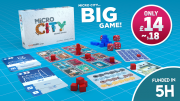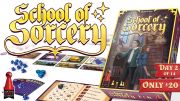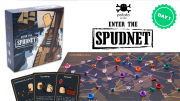Micro City (Thistroy Games) – In Micro City you are a city engineer, trying to complete a building card. Each building card has several stages to it, each of which requires a certain number of resources to complete. Each building card also has three different time requirements, which you can choose from in order to determine difficulty. The city board is placed on the city (it is made up of four cards, each of which shows four neighborhoods). Each round, you roll two dice, and you can spend resources to manipulate the results. During the second phase, you can either retrieve all your cards from the discard pile or play a card. Each card has three pieces of information: how many spots your engineer meeple will move on the city board, a basic action which does not cost dice, and the advanced action which requires you to have rolled the correct die result. Next, you can perform an action based on the location your meeple occupies on the city board. Micro City can be played solo, cooperatively, or competitively.
Casual Game Crowdfunding: Micro Cities and 100 Astronauts

The New Year is starting out strong, with some great looking casual games hitting Kickstarter—from a light card game about space colonies to a cooperative memory games with dogs. There are also a number of two player games this month: a new dice and card game from Dr. Finn's Games, a fantasy-themed sports game, and a city building game that can be played cooperatively, competitively, or even solo!
100 Astronauts (Red Red Wine) – Each player starts with a colony of ten astronauts. The goal is to reach one hundred. At the start of the game, six cards are dealt to each player. There are three types of cards in the game: blueprints (which have special effects), materials (which allow you to build the blueprint cards), and astronaut cards. Included in the blueprint cards are space bases, which players must build in order to house all one hundred astronauts on their colony. Six cards are placed face up on the table, which are the draft cards. Once per turn, the active player may exchange one card from his hand with a draft card. Players take turns in clockwise order. On your turn you draw one card from the deck and then may play as many cards as you wish from your hand. Each player also has a marketplace. You may place cards from your hand into your marketplace which indicates to other players that these cards are up for trade. The first player to reach one hundred astronauts wins!
Pavlov's Dogs (9th Level Games) – In this cooperative memory party game, players are dogs trying to complete a certain number of tests. Each round each player is dealt five cards face-down (they may not look at them). Players take turns flipping over a card and adding it into the center of the table. When you add a card, you must announce the sum of all the cards played so far this round. If a player ever makes a mistake, he loses a bone. If any player ever runs out of bones, the players lose the game. Complicating things is the fact that each round, a new special rule is introduced. These may change the values of certain cards, or require players to do a certain action when a type of card is played. At the beginning of each round, a new rule card is drawn, and then all rule cards are hidden during the round so that players must work to remember what they are.
School of Sorcery (Dr. Finn's Games) – School of Sorcery is a two-player game. There are six locations, numbered one through six. Each location contains a card. At the start of each round, players take five crystals. Both players each roll three dice and secretly assign a cast card from their hand to each die. Each player has six cast cards, all of which are available each round. After both players are done, the cards are revealed. These cards will have various effects, such as placing your crystals on the location card that corresponds to the die, while others may even manipulate your die before placing the crystals, allowing you to bluff your opponent. Each card played at a location is then checked. The card says how many crystals you need and how many crystals you need to beat your opponent by, in order to win the card. When you win a card, you place it in front of you, and a new card will be placed at that location at the end of the round. Cards are worth a number of points (the first player to thirteen points wins the game). Some cards also have special abilities to help you manipulate crystals during the game, either once per game or each round.
Dungeon Party (Forbidden Games) – In this dexterity, dungeon crawling themed game, heroes, dungeons, treasure, and monsters are all represented by drink coasters. When facing a monster, players take turns tossing coins, trying to have them land on the monster coasters. If it lands on the monster, it takes damage, otherwise the hero takes damage. The hero who lands the killing blow wins the monster's treasure. There are several different monsters in the game, as well as heroes with their own strengths and special abilities to add variety. You can read more about Dungeon Party here.
Dungeon Ball (Gabe Barrett) – In this fantasy themed football game, offense and defense plays out simply: on a turn, the player currently in defense selects a defense card from their hand of six cards and plays it face-down, trying to guess what offensive play the opponent is likely to choose. The offense has a grid of three by three squares, with each square representing a different play. The offense moves a pawn onto a square to select a play. The pawn must move to a space directly adjacent to the space it is already on, it cannot stay in the same space and it cannot move diagonally. The defense card is then revealed. If the defense card matches the color of the offense play, the defense earns a momentum token and the offense will lose a number of dice based on the defense card; if the color does not match, the offense adds that number of dice to their roll. The offense then rolls the correct number of dice, and may choose to reroll any number of them a second time (except those showing time icons). The offense player then compares her dice results to those required by the offensive play she chose. On the board, the football die is moved to the next space on the board that matches the play's color, for each set of dice that meet the play's requirement.
Potato Pirates 2: Enter The Spudnet (Codomo) – Potato Pirates was a card game, designed to help teach coding concepts. The creators have now designed Potato Pirates 2: Enter The Spudnet, a board game intended to help teach networking and cyber security concepts. Each player chooses a color and takes the relevant player tokens. You place your two warehouse tokens on the board in the zone that matches your player color. Each player then rolls their eight-sided die once for each colored zone except their own on the map, and places a potato token in the matching numbered location. The goal of the game is to send a ship from your warehouse to each of your potatoes. Each round there is a draft, place, and action phase. During the draft phase, the starting player takes the deck of ability cards, shuffles them, and draws cards equal to the number of players, plus one. He then chooses one card and passes the remaining cards to the player on the left; this is repeated until each player has a card. The last card is discarded. These cards can be played on your turn for various different effects. In the place phase, you place any ships not currently on the board, onto one of your warehouses. In the action phase, you may move each of your ships up to two spaces on the board.
Disclosure: unless otherwise noted, we have not seen or played any of the above games. Our assessment of each is based on the information given on the crowdfunding project page.











